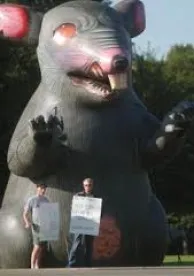One of labor unions’ key tactics relies prominently on balloon animals. Since the late 1980s, unions have used large inflatable animals – such as the infamous Scabby the Rat – to pressure employers and advertise labor disputes without running afoul of certain legal obligations. As we recently discussed on this blog, however, one recent court decision created questions about when unions may lawfully display Scabby, his pal Fat Cat, and any other inflatable animal buddies they may have. Then, earlier this month, the National Labor Relations Board released a memorandum showing that the Board itself might curtail this practice.
This is a key issue for unions and many employers, because the law significantly restricts how unions may publicize disputes at certain types of worksites. For example, when a union has a dispute with one employer but wants to publicize that dispute at another employer’s site (such as a dispute with a construction subcontractor working at a general contractor’s site), the law significantly restricts how the union may picket at the “neutral” employer’s site. Historically, courts and the Board have held that displaying inflatable animals does not constitute picketing for the purposes of the law in most situations, nor does displaying stationary banners with messages such as “Shame” or “Labor Dispute,” as distinguished from walking with picket signs. Courts and the Board also have extended other protections to these types of displays. These decisions have caused unions to rely heavily on Scabby and Fat Cat, as well as less cartoonish displays such as “Shame” banners.
In the Board’s recent memorandum, the Head of the Board’s Division of Advice advised another Board official (Regional Director Peter Ohr) to issue a complaint against a labor union that had displayed Fat Cat and a large stationary banner. The Division of Advice Head acknowledged that the Board historically has permitted these activities, but argued that prior Board decisions misinterpreted the law. Ultimately, the parties settled the case at hand, so it did not create a vehicle for the Board to change the current standard. Nevertheless, this memo strongly signals that the Board’s General Counsel plans to challenge the current standard for this type of “secondary picketing,” and will do so at the next opportunity.
Although the law has not changed yet, employers should monitor this issue as it develops, especially employers who share worksites with other entities or might find themselves facing disputes with labor unions. There is a good possibility that this pro-union precedent will be significantly clawed back.




 />i
/>i

